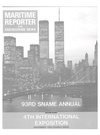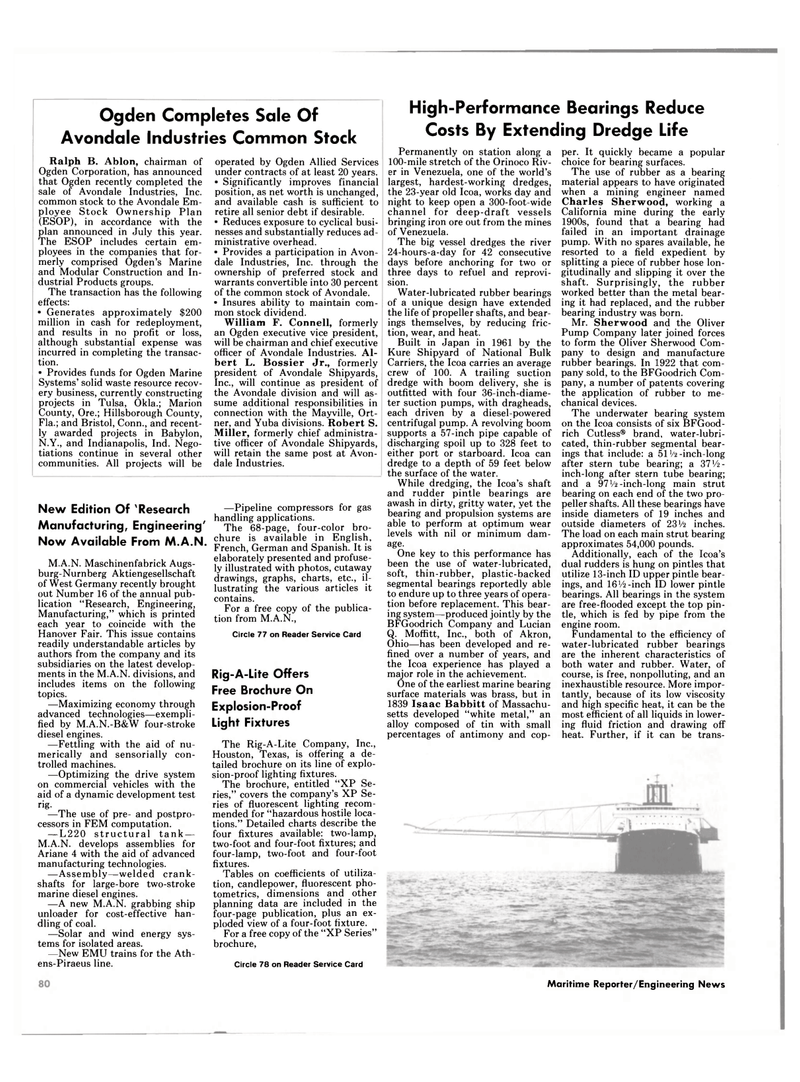
Page 74: of Maritime Reporter Magazine (November 1985)
Read this page in Pdf, Flash or Html5 edition of November 1985 Maritime Reporter Magazine
Ogden Completes Sale Of
Avondale Industries Common Stock
Ralph B. Ablon, chairman of
Ogden Corporation, has announced that Ogden recently completed the sale of Avondale Industries, Inc. common stock to the Avondale Em- ployee Stock Ownership Plan (ESOP), in accordance with the plan announced in July this year.
The ESOP includes certain em- ployees in the companies that for- merly comprised Ogden's Marine and Modular Construction and In- dustrial Products groups.
The transaction has the following effects: • Generates approximately $200 million in cash for redeployment, and results in no profit or loss, although substantial expense was incurred in completing the transac- tion. • Provides funds for Ogden Marine
Systems' solid waste resource recov- ery business, currently constructing projects in Tulsa, Okla.; Marion
County, Ore.; Hillsborough County,
Fla.; and Bristol, Conn., and recent- ly awarded projects in Babylon,
N.Y., and Indianapolis, Ind. Nego- tiations continue in several other communities. All projects will be operated by Ogden Allied Services under contracts of at least 20 years. • Significantly improves financial position, as net worth is unchanged, and available cash is sufficient to retire all senior debt if desirable. • Reduces exposure to cyclical busi- nesses and substantially reduces ad- ministrative overhead. • Provides a participation in Avon- dale Industries, Inc. through the ownership of preferred stock and warrants convertible into 30 percent of the common stock of Avondale. • Insures ability to maintain com- mon stock dividend.
William F. Connell, formerly an Ogden executive vice president, will be chairman and chief executive officer of Avondale Industries. Al- bert L. Bossier Jr., formerly president of Avondale Shipyards,
Inc., will continue as president of the Avondale division and will as- sume additional responsibilities in connection with the Mayville, Ort- ner, and Yuba divisions. Robert S.
Miller, formerly chief administra- tive officer of Avondale Shipyards, will retain the same post at Avon- dale Industries.
New Edition Of 'Research
Manufacturing, Engineering'
Now Available From M.A.N.
M.A.N. Maschinenfabrick Augs- burg-Nurnberg Aktiengesellschaft of West Germany recently brought out Number 16 of the annual pub- lication "Research, Engineering,
Manufacturing," which is printed each year to coincide with the
Hanover Fair. This issue contains readily understandable articles by authors from the company and its subsidiaries on the latest develop- ments in the M.A.N, divisions, and includes items on the following topics. —Maximizing economy through advanced technologies—exempli- fied by M.A.N.-B&W four-stroke diesel engines. —Fettling with the aid of nu- merically and sensorially con- trolled machines. —Optimizing the drive system on commercial vehicles with the aid of a dynamic development test rig. —The use of pre- and postpro- cessors in FEM computation. — L220 structural tank —
M.A.N, develops assemblies for
Ariane 4 with the aid of advanced manufacturing technologies. —Assembly—welded crank- shafts for large-bore two-stroke marine diesel engines. —A new M.A.N, grabbing ship unloader for cost-effective han- dling of coal. —Solar and wind energy sys- tems for isolated areas. —New EMU trains for the Ath- ens-Piraeus line. —Pipeline compressors for gas handling applications.
The 68-page, four-color bro- chure is available in English,
French, German and Spanish. It is elaborately presented and profuse- ly illustrated with photos, cutaway drawings, graphs, charts, etc., il- lustrating the various articles it contains.
For a free copy of the publica- tion from M.A.N.,
Circle 77 on Reader Service Card
Rig-A-Lite Offers
Free Brochure On
Explosion-Proof
Light Fixtures
The Rig-A-Lite Company, Inc.,
Houston, Texas, is offering a de- tailed brochure on its line of explo- sion-proof lighting fixtures.
The brochure, entitled "XP Se- ries," covers the company's XP Se- ries of fluorescent lighting recom- mended for "hazardous hostile loca- tions." Detailed charts describe the four fixtures available: two-lamp, two-foot and four-foot fixtures; and four-lamp, two-foot and four-foot fixtures.
Tables on coefficients of utiliza- tion, candlepower, fluorescent pho- tometries, dimensions and other planning data are included in the four-page publication, plus an ex- ploded view of a four-foot fixture.
For a free copy of the "XP Series" brochure,
Circle 78 on Reader Service Card
High-Performance Bearings Reduce
Costs By Extending Dredge Life
Permanently on station along a 100-mile stretch of the Orinoco Riv- er in Venezuela, one of the world's largest, hardest-working dredges, the 23-year old Icoa, works day and night to keep open a 300-foot-wide channel for deep-draft vessels bringing iron ore out from the mines of Venezuela.
The big vessel dredges the river 24-hours-a-day for 42 consecutive days before anchoring for two or three days to refuel and reprovi- sion.
Water-lubricated rubber bearings of a unique design have extended the life of propeller shafts, and bear- ings themselves, by reducing fric- tion, wear, and heat.
Built in Japan in 1961 by the
Kure Shipyard of National Bulk
Carriers, the Icoa carries an average crew of 100. A trailing suction dredge with boom delivery, she is outfitted with four 36-inch-diame- ter suction pumps, with dragheads, each driven by a diesel-powered centrifugal pump. A revolving boom supports a 57-inch pipe capable of discharging spoil up to 328 feet to either port or starboard. Icoa can dredge to a depth of 59 feet below the surface of the water.
While dredging, the Icoa's shaft and rudder pintle bearings are awash in dirty, gritty water, yet the bearing and propulsion systems are able to perform at optimum wear levels with nil or minimum dam- age.
One key to this performance has been the use of water-lubricated, soft, thin-rubber, plastic-backed segmental bearings reportedly able to endure up to three years of opera- tion before replacement. This bear- ing system—produced jointly by the
BFGoodrich Company and Lucian
Q. Moffitt, Inc., both of Akron,
Ohio—has been developed and re- fined over a number of years, and the Icoa experience has played a major role in the achievement.
One of the earliest marine bearing surface materials was brass, but in 1839 Isaac Babbitt of Massachu- setts developed "white metal," an alloy composed of tin with small percentages of antimony and cop- per. It quickly became a popular choice for bearing surfaces.
The use of rubber as a bearing material appears to have originated when a mining engineer named
Charles Sherwood, working a
California mine during the early 1900s, found that a bearing had failed in an important drainage pump. With no spares available, he resorted to a field expedient by splitting a piece of rubber hose lon- gitudinally and slipping it over the shaft. Surprisingly, the rubber worked better than the metal bear- ing it had replaced, and the rubber bearing industry was born.
Mr. Sherwood and the Oliver
Pump Company later joined forces to form the Oliver Sherwood Com- pany to design and manufacture rubber bearings. In 1922 that com- pany sold, to the BFGoodrich Com- pany, a number of patents covering the application of rubber to me- chanical devices.
The underwater bearing system on the Icoa consists of six BFGood- rich Cutless® brand, water-lubri- cated, thin-rubber segmental bear- ings that include: a 51V2-inch-long after stern tube bearing; a 37 ¥2. - inch-long after stern tube bearing; and a 97 V2-inch-long main strut bearing on each end of the two pro- peller shafts. All these bearings have inside diameters of 19 inches and outside diameters of 23 ¥2 inches.
The load on each main strut bearing approximates 54,000 pounds.
Additionally, each of the Icoa's dual rudders is hung on pintles that utilize 13-inch ID upper pintle bear- ings, and 16¥2-inch ID lower pintle bearings. All bearings in the system are free-flooded except the top pin- tle, which is fed by pipe from the engine room.
Fundamental to the efficiency of water-lubricated rubber bearings are the inherent characteristics of both water and rubber. Water, of course, is free, nonpolluting, and an inexhaustible resource. More impor- tantly, because of its low viscosity and high specific heat, it can be the most efficient of all liquids in lower- ing fluid friction and drawing off heat. Further, if it can be trans-
REFRIGERATION Maritime Reporter/Engineering News

 73
73

 75
75
